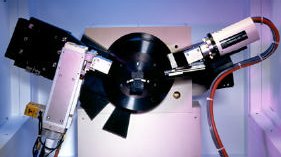 |
 |
|
X-ray diffraction
XRD Spectrometer
X-ray scattering techniques are versatile , non destructive and really efficient analytical techniques which reveal information about the crystallographic structure, chemical composition, and physical properties of materials and thin films. These techniques are based on observing the scattered intensity of an X-ray beam hitting a sample as a function of incident and scattered angle, polarization, and wavelength or energy.
Significance of XRD in CNT Carbon nanotubes have a multiple orientation as compared to the X/ray incident beam. Diameters and chiralities distribution are also observed as well as varios number of layers Os MWCNT’s. This leads to statistical characterisations of carbon nanotubes. Due to intrinsic nature, the main features of the X-ray diffraction pattern of cnt’s are close to that of graphite. A graphite like peak (002) is always present.Moreover, a family of peaks due to honeycomb lattice of single graphene sheet. Consequently,the x-ray diffraction profile is useful to determinate the sample purity and the presence of structural defects. CNT XRD Spectra
 View in High res
|
